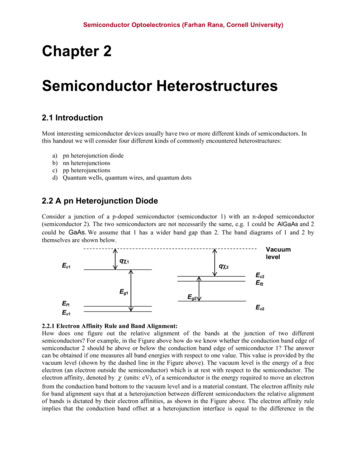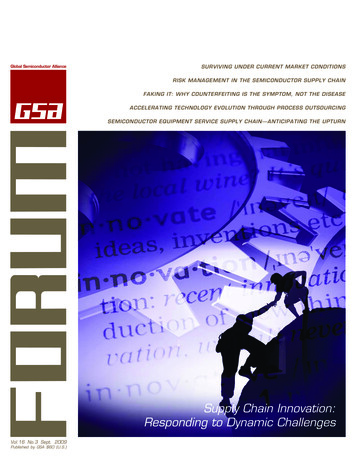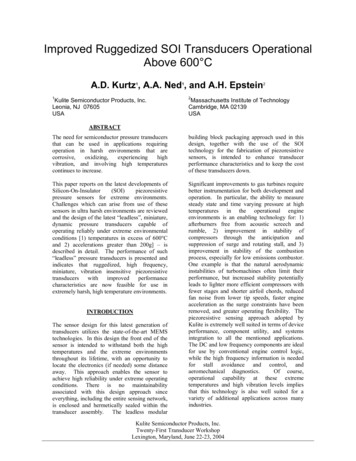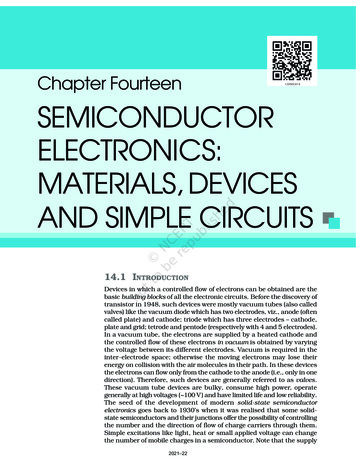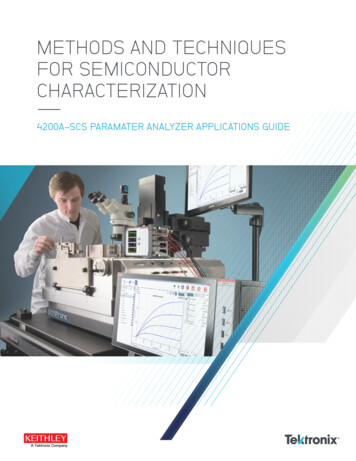Transcription
The Semiconductor EcosystemAuthor: Steve BlankGordian Knot Center forNational Security Innovationhttps://gordianknot.stanford.edu
The Semiconductor EcosystemThe last year has seen a ton written about the semiconductor industry: chip shortages, theCHIPS Act, our dependence on Taiwan and TSMC, China, etc.But despite all this talk about chips and semiconductors, few understandhow the industry is structured. I’ve found the best way to understandsomething complicated is to diagram it out, step by step. So here’s a quickpictorial tutorial on how the industry works.The Semiconductor EcosystemWe’re seeing the digital transformation of everything. Semiconductors – chips that processdigital information -- are in almost everything: computers, cars, home appliances, medicalequipment, etc. Semiconductor companies will sell 600 billion worth of chips this year.Looking at the figure below, the industry seems pretty simple. Companies in the semiconductorCompanies and Governmentsecosystem make chips (the triangle on the left) and sell themThat Use Chips in Systemsto companies and government agencies (on the right). Thosecompanies and government agencies then design 600 BillionSemiconductorthe chips into systems and devices (e.g. iPhones,EcosystemPCs, airplanes, cloud computing, etc.), and sell themto consumers, businesses, and governments. TheEnd Productsrevenue of products that contain chips is worth tens oftrillions of dollars.Yet, given how large it is, the industry remains amystery to most. If you do think of the semiconductor industry at all, you may picture workersin bunny suits in a fab clean room (the chip factory) holding a 12” wafer. Yet it is a business thatmanipulates materials an atom at a time and its factories cost 10s of billions of dollars to build.(By the way, that wafer has two trillion transistors onit.)If you were able to look inside the simple trianglerepresenting the semiconductor industry, instead of asingle company making chips, you would find anindustry with hundreds of companies, all dependenton each other. Taken as a whole it’s prettyoverwhelming, so let’s describe one part of theecosystem at a time. (Warning - this is a simplifiedview of a very complex industry.)The Semiconductor EcosystemSteve BlankGordian Knot Center for National Security Innovation v2
Semiconductor Industry SegmentsThe semiconductor industry has seven different types of companies. Each of these distinctindustry segments feeds its resources up the value chain to the next until finally a chip factory(a “Fab”) has all the designs, equipment, and materials necessary to manufacture a chip. Takenfrom the bottom up these semiconductor industry segments are:1.2.3.4.5.6.7.8.Chip Intellectual Property (IP) CoresElectronic Design Automation (EDA) ToolsSpecialized MaterialsWafer Fab Equipment (WFE)“Fabless” Chip CompaniesIntegrated Device Manufacturers (IDMs)Chip FoundriesOutsourced Semiconductor Assembly and Test(OSAT)The following sections below provide more detailabout each of these eight semiconductor industry segments.Chip Intellectual Property (IP) Cores The design of a chip may be owned by a single company, or Some companies license their chip designs - as software building blocks, called IP Cores for wide useThere are over 150 companies that sell chip IP CoresFor example, Apple licenses IP CoresChip IP Coresfrom ARM as a building block of theirmicroprocessors in their iPhones and ComputersElectronic Design Automation (EDA) Tools Engineers design chips (adding their own designs on top of any IP cores they’ve bought)using specialized Electronic DesignAutomation (EDA) softwareThe industry is dominated by threeU.S. vendors – Cadence, Mentor (now part of Siemens) and SynopsysIt takes a large engineering team using these EDA tools 2-3 years to design a complexlogic chip like a microprocessor used inside a phone, computer or server. (See the figureof the design process below.)Today, as logic chips continue to become more complex, all Electronic DesignAutomation companies are beginning to insert Artificial Intelligence aids to automateand speed up the processThe Semiconductor EcosystemSteve BlankGordian Knot Center for National Security Innovation v2
Specialized Materials and ChemicalsSo far our chip is still in software. But to turn it into something tangible we’re going to have tophysically produce it in a chip factory called a “fab.” The factories that make chips need to buyspecialized materials and chemicals: Silicon wafers – and to make those they need crystal growing furnaces Over 100 Gases are used – bulk gases (oxygen, nitrogen, carbon dioxide, hydrogen,argon, helium), and other exotic/toxic gases (fluorine, nitrogen trifluoride, arsine,phosphine, boron trifluoride, diborane, silane, and the list goes on.) Fluids (photoresists, top coats, CMP slurries) Photomasks Wafer handling equipment, dicing RF GeneratorsWafer Fab Equipment (WFE) Make the Chips These machines physically manufacture the chipsFive companies dominate the industry – Applied Materials, KLA, LAM, Tokyo Electronand ASMLThese are some of the most complicated (andexpensive) machines on Earth. They take a sliceof an ingot of silicon and manipulate its atomson and below its surfaceWe’ll explain how these machines are used abit later on“Fabless” Chip Companies Systems companies (Apple, Qualcomm, Nvidia, Amazon, Facebook, etc.) that previouslyused off-the-shelf chips now design their own chips.They create chip designs (using IP Cores and their own designs) and send the designs to“foundries” that have “fabs” that manufacture themThey may use the chips exclusively in theirown devices e.g. Apple, Google, Amazon .Or they may sell the chips to everyone e.g.AMD, Nvidia, Qualcomm, Broadcom They do not own Wafer Fab Equipment or usespecialized materials or chemicalsThey do use Chip IP and Electronic DesignSoftware to design the chipsThe Semiconductor EcosystemSteve BlankGordian Knot Center for National Security Innovation v2
Integrated Device Manufacturers (IDMs) Integrated Device Manufacturers (IDMs) design, manufacture (in their fabs), and sell theirown chips They do not make chips for other companies(this is changing rapidly - see here.) There are three categories of IDMs–Memory (e.g. Micron, SK Hynix), Logic (e.g.Intel), Analog (TI, Analog Devices)They have their own “fabs” but may also usefoundries They use Chip IP and Electronic DesignSoftware to design their chips They buy Wafer Fab Equipment and use specialized materials and chemicalsThe average cost of taping out a new leading-edge chip (3nm) is now 500 million.Chip Foundries Foundries make chips for others in their “fabs”They buy and integrate equipment from a variety ofmanufacturers Wafer Fab Equipment and specialized materialsand chemicalsThey design unique processes using this equipment tomake the chipsBut they don’t design chipsTSMC in Taiwan is the leader in logic, Samsung issecondOther fabs specialize in making chips for analog,power, rf, displays, secure military, etc.It costs 20 billon to build a new generation chip (3nm)fabrication plantFabs Fabs are short for fabrication plants – the factory that makes chipsIntegrated Device Manufacturers (IDMs) and Foundries both have fabs. The only differenceis whether they make chips for others to use or sell or make them for themselves to sell.Think of a Fab as analogous to a book printing plant (see figure below)1. Just as an author writes a book using a word processor, an engineer designs a chip usingelectronic design automation tools2. An author contracts with a publisher who specializes in their genre and then sends thetext to a printing plant. An engineer selects a fab appropriate for their type of chip(memory, logic, RF, analog)3. The printing plant buys paper and ink. A fab buys raw materials; silicon, chemicals, gasesThe Semiconductor EcosystemSteve BlankGordian Knot Center for National Security Innovation v2
4. The printing plant buys printing machinery, presses, binders, trimmers. The fab buyswafer fab equipment, etchers, deposition, lithography, testers, packaging5. The printing process for a book uses offset lithography, filming, stripping, blueprints,plate making, binding and trimming. Chips are manufactured in a complicated processmanipulating atoms using etchers, deposition, lithography. Think of it as an atomic leveloffset printing. The wafers are then cut up and the chips are packaged6. The plant turns out millions of copies of the same book. The plant turns out millions ofcopies of the same chipWhile this sounds simple, it’s not. Chips are probably the most complicated products evermanufactured. The diagram below is a simplified version of the 1000 steps it takes to make achip.The Semiconductor EcosystemSteve BlankGordian Knot Center for National Security Innovation v2
Outsourced Semiconductor Assembly and Test (OSAT) These companies’ package andtest chips made by foundries andIDMs OSAT companies take the wafermade by foundries, dice (cut)them up into individual chips, testthem and then package them andship them to the customerFab Issues As chips have become denser(with trillions of transistors on asingle wafer) the cost of building fabs have skyrocketed – now 10 billion for one chipfactoryOne reason is that the cost of the equipment needed to make the chips has skyrocketedo Just one advanced lithography machine from ASML, a Dutch company, costs 150milliono There are 500 machines in a fab (not all as expensive as ASML)o The fab building is incredibly complex. The clean room where the chips are made isjust the tip of the iceberg of a complex set of plumbing feeding gases, power, liquidsall at the right time and temperature into the wafer fab equipmentThe multi-billion-dollar cost of staying at the leading edge has meant most companies havedropped out. In 2001 there were 17 companies making the most advanced chips. Todaythere are only two – Samsung in Korea and TSMC in Taiwan.o Given that China believes Taiwan is a province of China this could be problematic forthe West.The Semiconductor EcosystemSteve BlankGordian Knot Center for National Security Innovation v2
What’s Next - TechnologyIt’s getting much harder to build chips that are denser, faster, and use less power, so what’snext? Instead of making a single processor do all the work, logic chip designers have putmultiple specialized processors inside of a chip Memory chips are now made denser by stacking them 100 layers high As chips are getting more complex to design, which means larger design teams, andlonger time to market, Electronic Design Automation companies are embedding artificialintelligence to automate parts of the design process Wafer equipment manufacturers are designing new equipment to help fabs make chipswith lower power, better performance, optimum area-to-cost, and faster time tomarketWhat’s Next – BusinessThe business model of Integrated Device Manufacturers (IDMs) like Intel is rapidly changing. Inthe past there was a huge competitive advantage in being vertically integrated i.e. having yourown design tools and fabs. Today, it’s a disadvantage. Foundries have economies of scale and standardization. Rather than having to invent itall themselves, they can utilize the entire stack of innovation in the ecosystem. And justfocus on manufacturing AMD has proven that it's possible to shift from an IDM to a fabless foundry model.Intel is trying. They are going to use TSMC as a foundry for their own chips as well as setup their own foundryWhat’s Next – GeopoliticsControlling advanced chip manufacturing in the 21st century may well prove to be likecontrolling the oil supply in the 20th. The country that controls this manufacturing can throttlethe military and economic power of others. Ensuring a steady supply of chips has become a national priority. (China’s largest importby ’s are semiconductors – larger than oil) Today, both the U.S. and China are rapidly trying to decouple their semiconductorecosystems from each other; China pouring 100 billion of government incentives inbuilding Chinese fabs, while simultaneously trying to create indigenous supplies of waferfab equipment and electronic design automation software Over the last few decades the U.S. moved most of its fabs to Asia. Today we areincentivizing bringing fabs and chip production back to the U.S.An industry that previously was only of interest to technologists is now one of the largest piecesin great power competition.The Semiconductor EcosystemSteve BlankGordian Knot Center for National Security Innovation v2
used off-the-shelf chips now design their own chips. They create chip designs (using IP Cores and their own designs) and send the designs to "foundries" that have "fabs" that manufacture them They may use the chips exclusively in their own devices e.g. Apple, Google, Amazon . Or they may sell the chips to everyone e.g.


